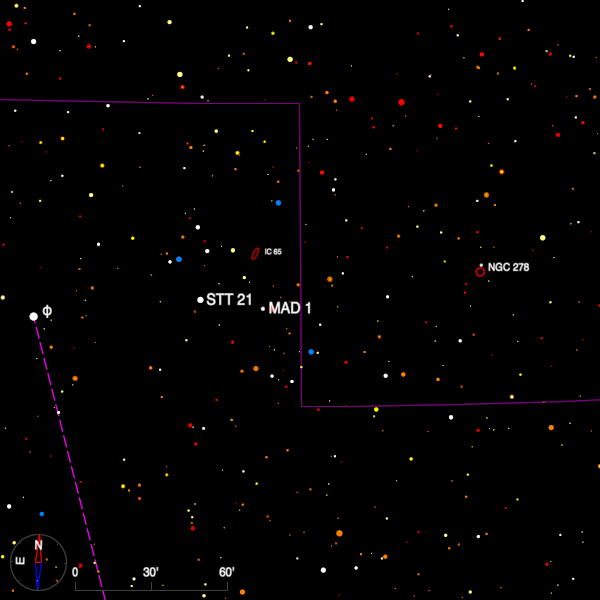November 2022 - Double Star of the Month
In the corresponding column for this month in 2021, I mentioned a number of pairs close to the bright, close binary phi Andromedae. As promised this piece will include the pairs MAD 1 (01 00 35.58 +47 19 14.6) and STT 21 (01 03 01.54 +47 22 34.1).

STT 21 is about 1.5 degrees west of phi And and is now considerably easier to observe than in the 1840s when the separation was 0".6 The current orbit of 450 year period was published by W. D. Heintz in 1966 and predicts a position of 176 degrees and 1".2 for late 2022. The apparent orbit is one of high eccentricity and inclination and the apparent motion appears to be almost linear. The magnitudes are 6.8 and 8.1 and the pair should be resolved in 15-cm aperture.
Johann Madler (1794 - 1874) succeeded F. G. W. Struve as Director of Dorpat Observatory where the main instrument was Fraunhofer's 9.3-inch refractor with which Struve had carried out his great survey of double stars. MAD 1 can be found half a degree west of STT 21. It is a long period binary with main components of magnitudes 7.7 and 9.1. When first observed the separation was 1" but the stars have been closing slowly and at the present time are 0".74 apart in PA 356 degrees, if the 2127 year orbit currently in the catalogue is accurate.
HJ 5437 (00 00 34.35 -53 05 51.8) sits in southern Phoenix 20 arc-minutes to the south-east of the red giant pi Phe (V = 5.1).

It is not labelled in the second edition of the Cambridge Double Star Atlas, and was found by John Herschel in 1836 at 340 degrees and 2".5 since then has been slowily closing. In 2019 the stars were at 340 degrees and 1".4 and as the magnitudes are respectively 6.9 and 9.9 this is a rather difficult pair which probably needs at least 20-cm.
Although the observed motion only amounts to 44 degrees, a premature orbit with a period of 904 years is listed in the online USNO 6th orbit catalogue. Incidentally the USNO double star website is back on-line and can be found at crf.usno.navy.mil. The WDS catalogue is available again but the latest update appears to have been about 2 months ago.
Bob Argyle - Double Star Section Director